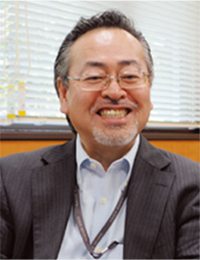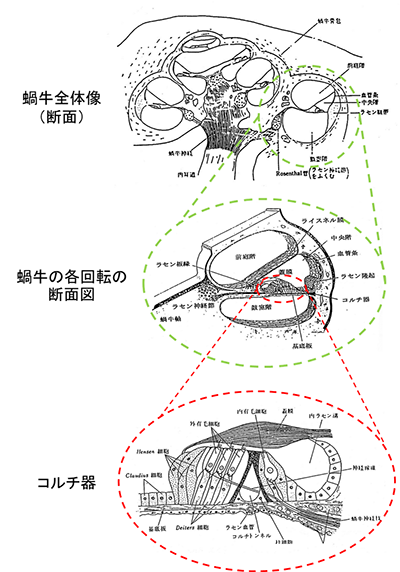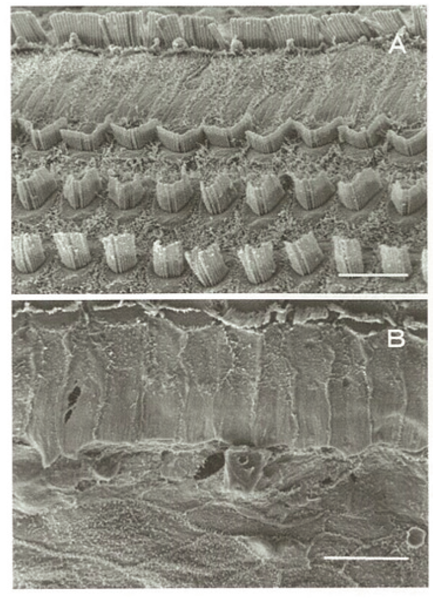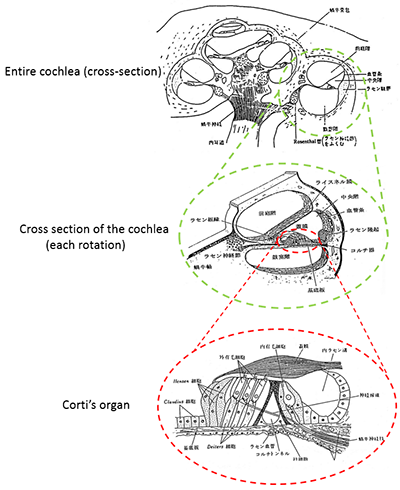キーワード: 感覚系、聴覚、蝸牛(かぎゅう)、有毛細胞
http://www.md.tsukuba.ac.jp/clinical-med/otorhinolaryngology/
 聴覚障害により音が聞こえにくくなる難聴は、音声言語によるコミュニケーションの大きな障害となります。難聴には音の伝えが悪いために生じる伝音難聴と、聞こえの神経に障害があるために生じる感音難聴があります。リサーチユニット「聴覚障害発症機序の解明に関する検討」は、感音難聴の発症メカニズムを探り、難聴治療に結びつけることを目指すリサーチユニットです。
聴覚障害により音が聞こえにくくなる難聴は、音声言語によるコミュニケーションの大きな障害となります。難聴には音の伝えが悪いために生じる伝音難聴と、聞こえの神経に障害があるために生じる感音難聴があります。リサーチユニット「聴覚障害発症機序の解明に関する検討」は、感音難聴の発症メカニズムを探り、難聴治療に結びつけることを目指すリサーチユニットです。
音の振動を電気信号に変換する耳の奥の小さな器官、蝸牛
感音難聴の多くは内耳性難聴で、突発性難聴やメニエル病など症例数も多い疾患ですが、その治療法が確立していないのが現状です。内耳には蝸牛という器官があり、内耳性難聴の多くにおいてこの器官の障害が関係しています。蝸牛は骨に囲まれた場所に位置する小さな器官なため、非常に扱いが難しく基礎研究が遅れていました。しかし近年、蝸牛には外有毛細胞と内有毛細胞と呼ばれる受容器があり、これらの細胞により音の振動が電気信号に変換されていることなどが分かってきました(図1)。

図1:蝸牛の全体像と各部分の拡大図。コルチ器にある有毛細胞により音の振動が電気信号に変換される
内耳障害の原因・病態・障害過程 ひとつひとつのパーツをつなぐ
内耳性難聴発症メカニズム解明のためにモルモット、ラット等の実験動物を用いた病態モデルによる研究を行っています。一例として、突発性難聴については血流障害説と考え、血流を一時的に遮断することで病態モデルを作成し、蝸牛で起こる障害について調べています。血流遮断(虚血)による酸素欠乏で細胞に障害が起こるだけではなく、再灌流によって細胞が障害されること、特に外有毛細胞でその影響が大きいことが分かってきています(図2)。このような虚血・再灌流による障害の特徴に注目し、細胞組織障害が起こる詳細な過程を調べるとともに、治療への試みとして薬物学的なアプローチも行っています。
また、突発性難聴の他、急性音響外傷、メニエル病、薬物性難聴などの内耳性難聴についても同様に治療に向けた基礎的研究を行っています。

図2:血流遮断と再灌流による有毛細胞の聴毛障害の様子
( A:虚血非負荷、B:虚血負荷後)
「内耳性難聴の治療に向けてー病態モデルを用いたアプローチー(原晃 著)」より転載
社会への貢献・実績
- 内耳性難聴発症メカニズムの解明と内耳性障害研究の発展
- 内耳性障害の病態に即した新たな治療法開発
取材:平成26年7月2日
For the treatment of inner ear hearing loss
Unit members : Takahashi, Satoru Tanaka Shuho Tabuchi, Keiji Nakayama, Masahiro
Unit name: Elucidation of Pathogenic Mechanisms of Auditory Impairment
Key words: sensory system, auditory sensation, cochlea, hair cell
 Hearing loss, which is difficulty in hearing due to auditory impairment, presents marked barriers to communication. Hearing loss is classified into conductive hearing loss due to poor sound conduction and sensorineural hearing loss due to damage to the nerve for hearing. The Research Unit “Elucidation of Pathogenic Mechanisms of Auditory Impairment” aims to clarify the pathogenic mechanism of sensorineural hearing loss for the treatment of hearing loss.
Hearing loss, which is difficulty in hearing due to auditory impairment, presents marked barriers to communication. Hearing loss is classified into conductive hearing loss due to poor sound conduction and sensorineural hearing loss due to damage to the nerve for hearing. The Research Unit “Elucidation of Pathogenic Mechanisms of Auditory Impairment” aims to clarify the pathogenic mechanism of sensorineural hearing loss for the treatment of hearing loss.
Cochlear, a small organ in the inner ear that converts sound vibrations to electrical signals
Most cases of sensorineural hearing loss are cases of inner ear hearing loss, such as sudden sensorineural hearing loss and Meniere’s disease, that are frequently observed. However, there is no established treatment method for inner ear hearing loss at present. In the inner ear, the cochlea is present, and damage to this organ is frequently associated with inner ear hearing loss. Since the cochlea is a small organ surrounded by bone and difficult to treat, basic studies on the cochlea have been delayed. However, studies in recent years have shown the presence of receptors called outer and inner hair cells in the cochlea and conversion of sound vibrations into electrical signals by these cells (Fig. 1).

Figure 1: The entire cochlea and enlarged view of each part Sound vibrations are converted into electrical signals by hair cells in the Corti’s organ
Connecting the cause of inner ear disorders, their pathology, and the impairment process together
To clarify the pathogenic mechanism of inner ear hearing loss, we have performed studies in experimental animals, such as rats, as pathologic models. Supporting “the impaired blood flow theory” for sudden sensorineural hearing loss, we produced a pathological model by transiently interrupting blood flow, and evaluated damage in the cochlea. Cell injury occurred not only due to oxygen deficiency caused by blood flow interruption (ischemia) but also due to subsequent reperfusion, and particularly marked damage was observed in outer hair cells. Noting the characteristics of injury due to ischemia ∙ reperfusion, we have evaluated the detailed process of histological cell injury, and also used pharmacological approaches as a trial for treatment.
In addition to sudden sensorineural hearing loss, basic studies on other types of inner ear hearing loss, such as acute acoustic trauma, Meniere’s disease, and drug-induced hearing loss, have also been performed.

Figure 2: Hair damage of hair cells due to blood flow interruption and reperfusion (A: No ischemia, B: After ischemia) “For the treatment of inner ear hearing loss- an approach using a pathologic model- (by Noboru Hara)”
Social contributions and achievements
– Elucidation of the pathogenic mechanism of inner ear hearing loss and the development of research on inner ear disorders
– Development of new treatment methods based on the pathology of inner ear disorders
Interviewed on July 2, 2014
